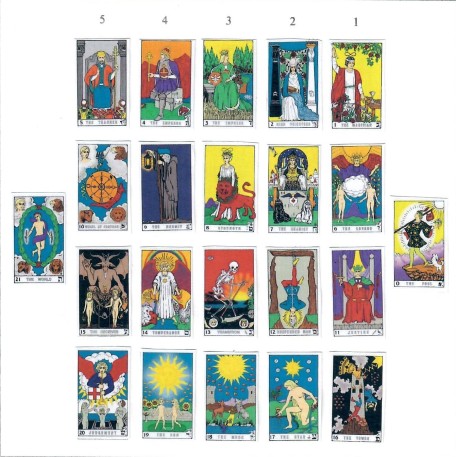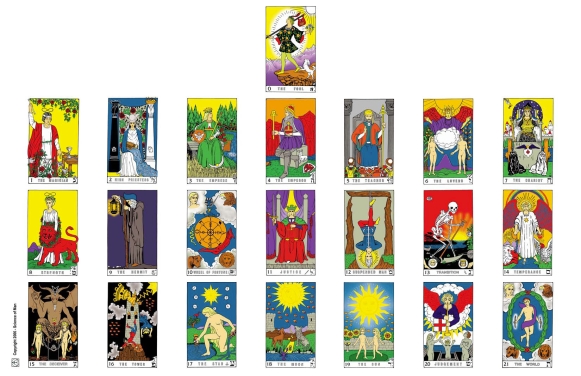 The deck of Tarot cards that I will be using were created by Rt. Rev. Helen Blighton for use in the Holy Order of MANS seminary in the late 1960’s and were based on Paul Foster Case’s deck. Jason C. Lotterhand, Director of the Builders of the Adytum, Ltd. gave a series of lectures at the Holy Order of MANS on the Tarot in the early 1970’s.
The deck of Tarot cards that I will be using were created by Rt. Rev. Helen Blighton for use in the Holy Order of MANS seminary in the late 1960’s and were based on Paul Foster Case’s deck. Jason C. Lotterhand, Director of the Builders of the Adytum, Ltd. gave a series of lectures at the Holy Order of MANS on the Tarot in the early 1970’s.
From her book, Jewels of the Wise, Helen Blighton created a Tarot Tableau which places The Fool Key 0 alone on the far right, with the cards arranged with both columns and letters of the alphabet reading from right to left. Therefore, the top horizontal row contains Key 1, starting at the right, through 5. The 2nd horizontal row has Key 6 (at the right) through Key 10. The next row Keys 11 through 15. The 3rd row has Keys 16 through 20. According to Helen Blighton, “The Hebrew language is always written in this way, right to left, and this arrangement permits The Fool to move forward into the manifestation of all his potential.”
If you arrange your deck in this order you will see that this Tarot Tableau creates five columns of four cards each and the last card, The World Key 21, stands alone on the far left. By this arrangement the 1st vertical column, on the right, deals with thought and a study in mentality, the 2nd column deals with various functions of alchemical Water. Column 3 investigates the subconscious in respect to growth and change. The 4th column deals with degrees of accomplishment. The cards in column 5 are a series of triplicities. I will create a study of each of these 5 columns in future posts.
You may also wish to color your own set of cards and then arrange them in front of you as you read about each Key. Please click here to go to my post on purchasing and coloring the cards. With each deck of cards comes coloring instructions.

In Paul Foster Case’s book The Tarot, A Key to the Wisdom of the Ages, he created this Tarot Tableau attributing the major trumps to each of the letters of the Hebrew alphabet. Hebrew letters are nouns, so according to him they are also 22 labels for mental pictures. He spoke of the Tarot as “a pictorial text-book of Ageless Wisdom.”
This is one of many ways to arrange the Tarot Keys, but the importance of this particular combination is that the Keys are in numeric order from 0 to 21. Since we are reading the Keys, as you would a story book, you will find that reviewing them in this order allows you to see that each Key builds on the previous Keys. And in some cases, such as the Chariot, a Key can be a summary of an entire row of Keys. Beginning with this arrangement allows you to get a basic grasp of the Keys and how they interact with each other.
We will cover each of the Case’s columns made up of three Keys in future posts. Paul Foster Case created a system of study covering each row and each column of this table, which I will use as a foundation for discussion. As an overview, for now, each row has an attribute. The top row contains 7 dominant mental states or principles. The second row typifies intermediary activities or agencies. And the bottom row represents conditions or results from the expression of the principles of the upper row through the agencies of the middle row.
According to Paul Foster Case, beginning with the first column on the left, the 7 columns represent bondage, awakening, revelation, organization, regeneration, realization, and cosmic consciousness. Pretty heady stuff! So first we will read and understand the symbols of each Key before we embark on how they unfold in us the meanings of each column.
